In recent years, urban gardening has gained popularity as more people recognize the benefits of growing their own food. Urban environments, with limited space and often harsh conditions, present unique challenges for gardeners. However, with a bit of planning and the right choices, anyone can cultivate a productive food garden—even on a small balcony or windowsill.
In this guide, we’ll walk you through nutritious, beginner-friendly foods you can grow at home, from crunchy greens and aromatic herbs to nutrient-dense root veggies. Whether you’re in a small apartment or have a spacious backyard, these easy-growing options can bring flavor, health benefits, and a sense of accomplishment to your meals. Let’s dive in!
Why Grow Your Own Food?
Before we dive into what to plant, let’s look at why growing your own food is worthwhile:
- Freshness and Nutritional Value: Homegrown fruits, vegetables, and herbs can be harvested at their peak, ensuring optimal flavor and nutritional content.
- Environmental Impact: By reducing the need for transportation and packaging, you’ll shrink your carbon footprint and contribute to a more sustainable lifestyle.
- Mental Health Benefits: Gardening has been shown to reduce stress and improve mood. Tending to plants can be a mindful, relaxing activity in a busy urban lifestyle.
- Cost Savings: After initial setup costs, growing your own produce can save money, especially for items like herbs that are often pricey in stores.
Now, let’s delve into some of the best foods you can grow in a small space, along with tips for success.
1. Herbs: Essential Flavors in Compact Spaces
Herbs are beginner-friendly, space-efficient, and add fresh flavors to any meal. Many herbs also have medicinal and health benefits, making them doubly valuable in your kitchen.
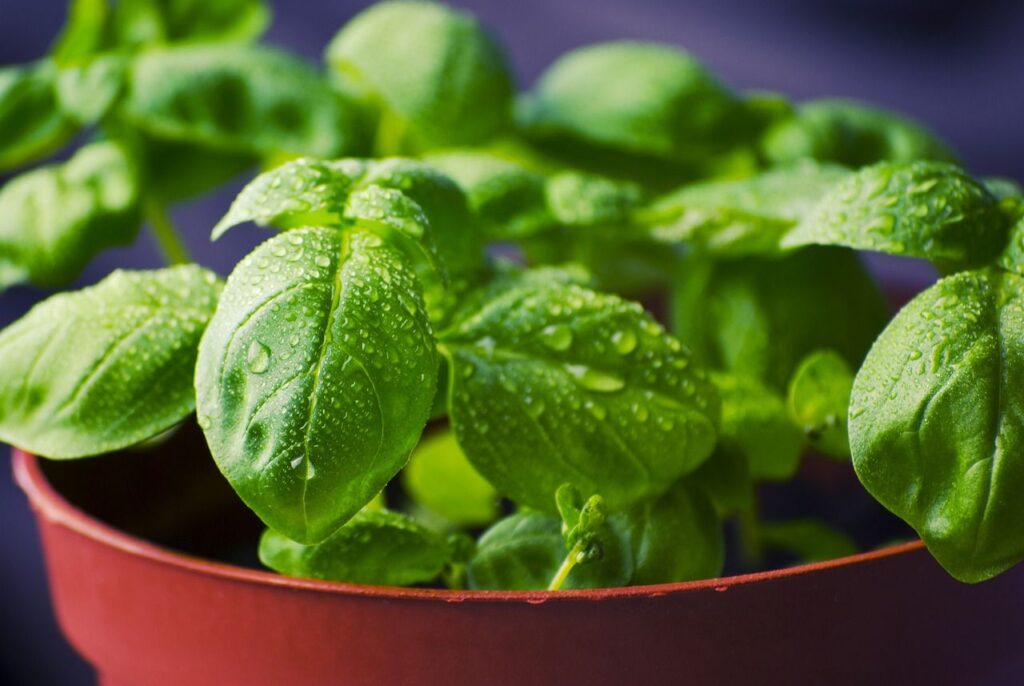
- Basil: This Mediterranean herb loves sunlight and warm temperatures, making it ideal for a sunny windowsill or balcony. Regularly trim basil leaves to encourage bushy growth and prevent flowering, which can make the leaves bitter.
- Ideal Uses: Pesto, sauces, salads.
- Growing Tips: Plant basil in rich, well-draining soil, and water it regularly.
- Mint: A hardy herb that can thrive indoors or outdoors. Mint spreads quickly, so it’s best to plant it in its own pot to avoid overcrowding other plants.
- Ideal Uses: Teas, desserts, savory dishes.
- Growing Tips: Keep mint in indirect sunlight and water it consistently. Mint also responds well to regular trimming.
- Cilantro: Preferring cooler weather, cilantro can be tricky in high temperatures but does well in partially shaded spots.
- Ideal Uses: Salsas, curries, garnishes.
- Growing Tips: Allow cilantro to self-seed by letting it flower, or cut it back frequently to delay bolting (flowering).
2. Leafy Greens: Fresh, Nutritious, and Fast to Harvest
Leafy greens are great for small spaces and provide a quick, continuous harvest, as most varieties regrow after being trimmed.

- Lettuce: Lettuce varieties like loose-leaf and romaine can grow well in pots and shallow containers. Lettuce needs partial sunlight and frequent watering to prevent bitterness.
- Harvesting: Lettuce is ready to harvest in 4–6 weeks. Trim outer leaves as you need them, allowing the plant to continue growing.
- Spinach: A nutrient powerhouse, spinach prefers cooler weather, so it’s perfect for early spring and fall.
- Harvesting: Spinach is generally ready within 6–8 weeks. Harvest leaves regularly to encourage new growth.
- Arugula: Known for its peppery flavor, arugula is easy to grow and can be harvested multiple times in a season.
- Growing Tips: Arugula thrives in containers and doesn’t need much sunlight, making it perfect for indoor gardening.
3. Tomatoes: The Star of Container Gardens
Tomatoes are one of the most rewarding plants to grow, as they’re productive and versatile in the kitchen. Many varieties are bred specifically for container gardening, like cherry tomatoes and small bush varieties.
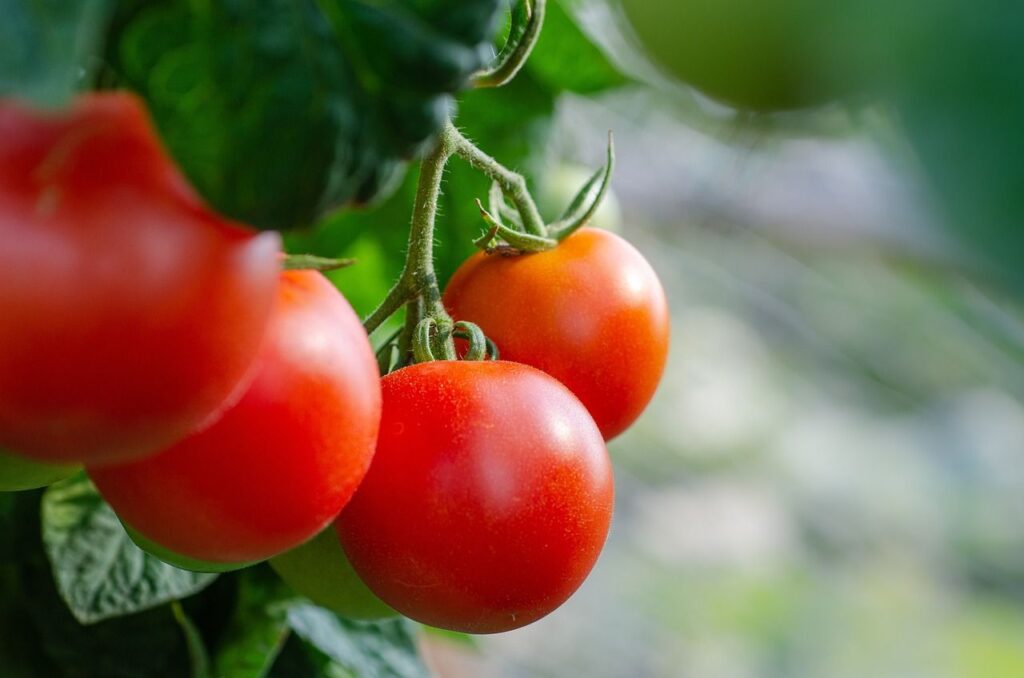
- Cherry Tomatoes: Small and fast-growing, cherry tomatoes are ideal for pots and thrive in full sunlight.
- Growing Tips: Support your tomato plant with a small trellis or stake. Ensure the pot has good drainage, and water consistently to prevent fruit splitting.
- Roma Tomatoes: Larger than cherry tomatoes, Roma tomatoes are ideal for sauces and soups. They require a bit more space but can still thrive on a balcony.
- Growing Tips: Roma tomatoes need slightly larger containers and strong support as they grow.
4. Peppers: Small but Productive
Peppers, from sweet bell varieties to spicy chilis, grow well in pots and are perfect for adding color and flavor to your garden.
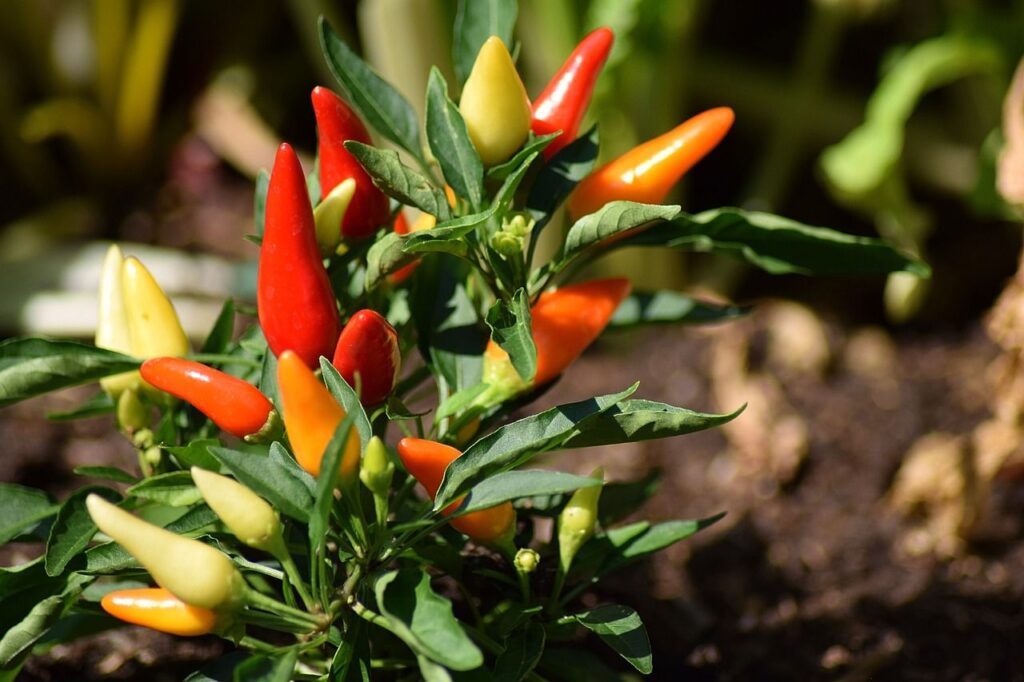
- Bell Peppers: These vibrant vegetables thrive in warm, sunny spots. They need regular watering but should not be overwatered, as soggy soil can harm the roots.
- Growing Tips: Bell peppers can be grown in medium-sized pots. As they mature, use stakes or small cages to keep the plants upright.
- Chili Peppers: Compact and productive, chili peppers add heat to your dishes. They grow best in full sunlight and can tolerate a variety of conditions.
- Growing Tips: Chilies need well-draining soil and regular watering, but allow the soil to dry slightly between waterings.
5. Root Vegetables: Radishes and Carrots
Root vegetables like radishes and carrots are surprisingly easy to grow in containers, given the right soil depth.
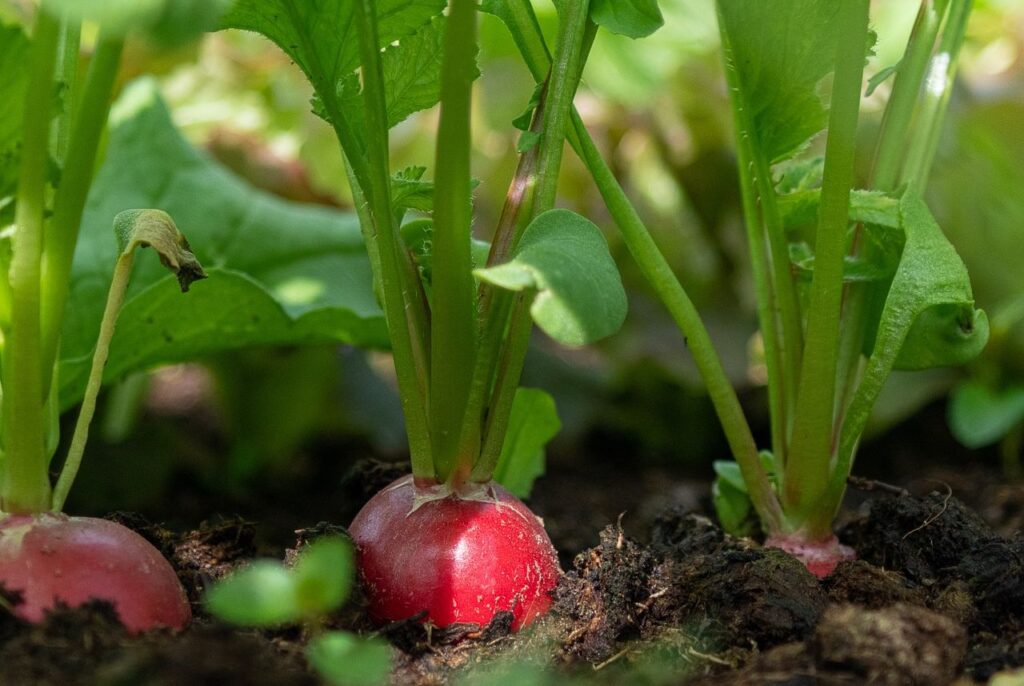
- Radishes: Radishes are among the fastest-growing vegetables, ready to harvest in just a few weeks.
- Growing Tips: Radishes prefer cooler weather, so they’re great for early spring and fall planting. They need well-draining soil and partial sunlight.
- Harvesting: Harvest radishes when they’re about an inch in diameter for the best flavor.
- Carrots: Carrots need a deep container with loose, sandy soil to grow straight and long.
- Growing Tips: Choose a compact variety like ‘Thumbelina’ if you’re working with limited space.
- Harvesting: Carrots usually mature within 10–12 weeks. Pull them gently from the soil to avoid breaking the root.
6. Green Beans: Ideal for Vertical Spaces
Green beans are a fantastic option for vertical gardening, which maximizes limited space by allowing plants to grow upward on trellises or stakes.
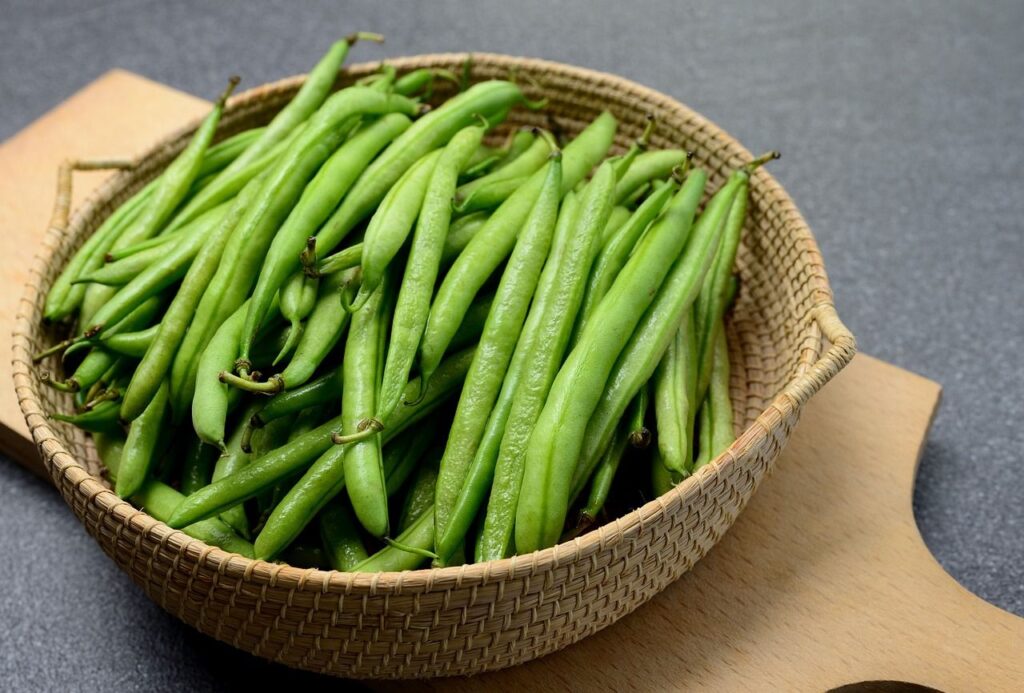
- Pole Beans: These beans climb upwards, so they require a support system like a trellis or bamboo stakes.
- Growing Tips: Place the container in full sunlight and water consistently. Beans grow quickly and will need sturdy support as they produce pods.
- Bush Beans: Unlike pole beans, bush beans are shorter and can grow in regular containers without a trellis.
- Harvesting: Beans are ready to pick when they reach a few inches long. Regular harvesting encourages more pods to form.
7. Strawberries: A Sweet Treat in Small Spaces
Strawberries grow well in pots or even hanging baskets, making them perfect for balconies and patios. With minimal care, they produce sweet, juicy fruits.

- Growing Tips: Strawberries prefer slightly acidic, well-draining soil and need at least 6 hours of sunlight daily.
- Harvesting: Strawberries typically produce fruit in late spring or early summer. Pick them as soon as they’re fully red for the best taste.
8. Microgreens: Quick and Nutrient-Dense
Microgreens are tiny, nutrient-packed plants that you can grow indoors with minimal space. Radish, broccoli, sunflower, pea shoots, arugula, beet, mustard, and kale are all easy-to-grow microgreens perfect for a home garden.
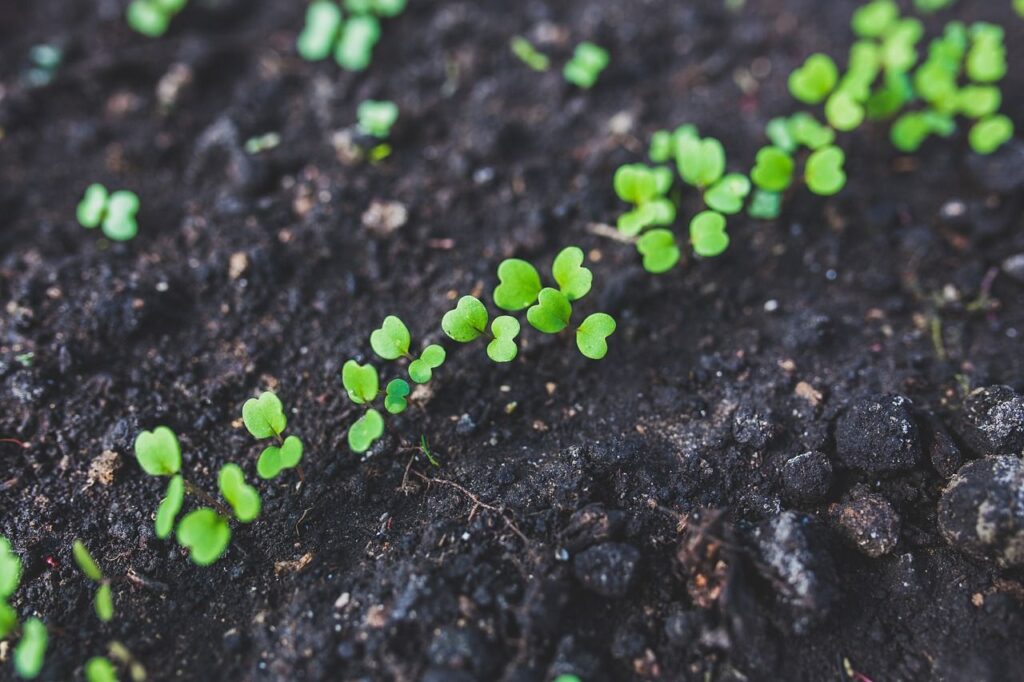
- Popular Varieties: Sunflower, radish, arugula, and broccoli are common microgreens.
- Growing Tips: Use a shallow container with drainage holes and a light layer of potting mix. Scatter seeds and mist them daily. Microgreens thrive on windowsills with indirect sunlight.
- Harvesting: Microgreens are ready to harvest within 1–2 weeks. Snip them at the base for a fresh garnish or salad topping.
9. Potatoes: A Staple Crop in Small Spaces
Potatoes are easy to grow in grow bags or deep containers, making them a great option for urban gardeners.

- Growing Tips: Plant seed potatoes in a large container with a depth of at least 12 inches. Cover the sprouting potatoes with soil as they grow.
- Harvesting: Once the plants flower and the leaves start to turn yellow, it’s time to harvest. Simply dump out the container and sift through the soil for your homegrown potatoes.
10. Onions and Garlic: Flavor Essentials
Onions and garlic are kitchen essentials that are easy foods you can grow at home with very little upkeep.
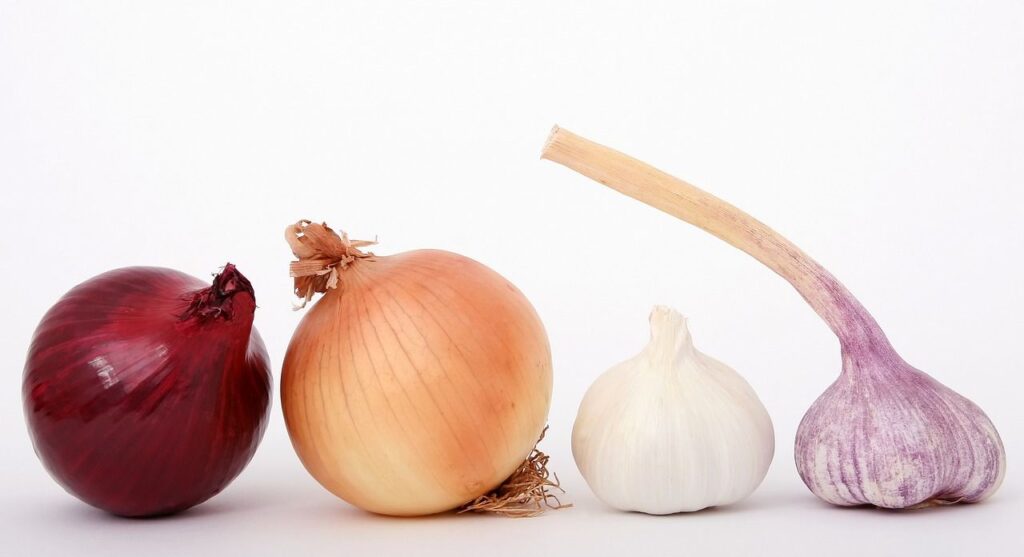
- Growing Tips: Both onions and garlic prefer full sun and well-draining soil. Plant garlic cloves or onion sets in individual pots or a shared container with sufficient space.
- Harvesting: Garlic takes about 8–9 months to mature, while onions vary depending on the variety. Both can be harvested once their tops begin to wilt and dry out.
Discover More: Improving Gut Health by Making the Right Choices
Tools You Might Need for Home Gardening
Having the right tools for home gardening can make the process easier, more efficient, and more enjoyable. Even with a small indoor or balcony garden, a few basic tools are essential. Here’s a list of tools you might need to get started with home gardening, along with their uses:
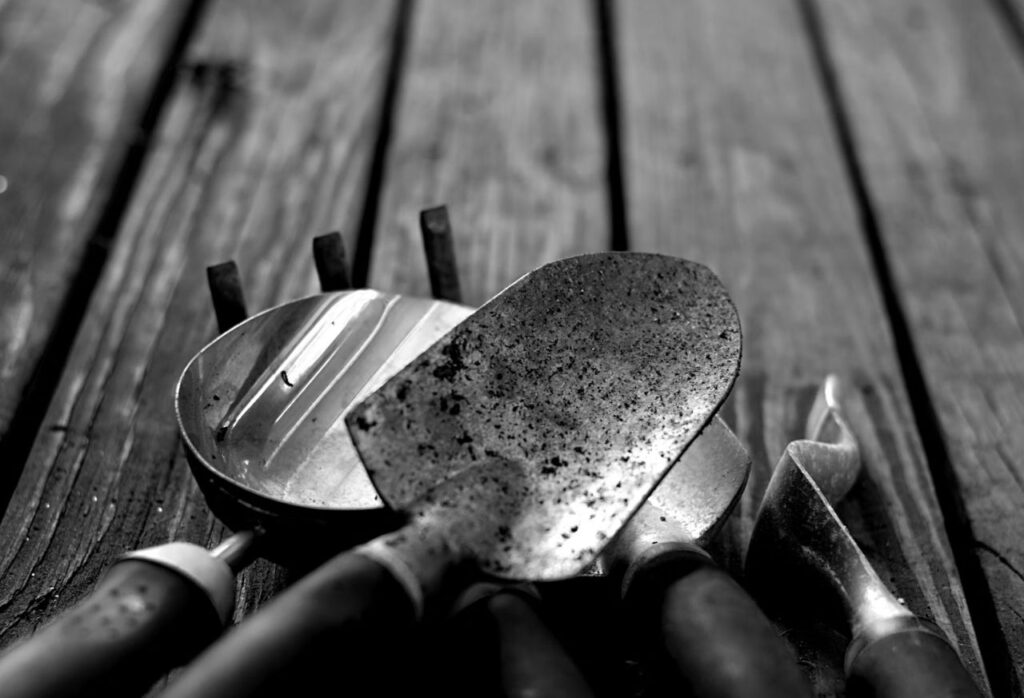
1. Hand Trowel
A hand trowel is one of the most basic yet essential gardening tools. It’s used for digging small holes, planting, transplanting seedlings, and scooping soil or compost.
Tip: Look for a sturdy, stainless-steel trowel with a comfortable handle, as it will be durable and resistant to rust.
2. Pruning Shears (Hand Pruners)
Pruning shears are used to trim and shape plants, remove dead or damaged stems, and encourage healthy growth. They’re especially useful for pruning herbs, small shrubs, and flowers.
Tip: Choose a sharp, high-quality pair that fits comfortably in your hand. Bypass pruners are ideal for clean cuts, while anvil pruners work well for thicker, woody stems.
3. Watering Can or Spray Bottle
A watering can allows you to control water flow and is ideal for container plants. For indoor plants or delicate seedlings, a spray bottle or small misting bottle is perfect for gentle watering.
Tip: Choose a watering can with a narrow spout to prevent over-watering and splashback, especially for indoor plants. A spray bottle is also useful for misting plants that prefer high humidity.
4. Garden Gloves
Gloves protect your hands from dirt, thorns, and potential skin irritants, especially when working with potting soil or handling plants with spiky leaves. They’re essential for any gardening activity that involves contact with soil or plant material.
Tip: Choose gloves that fit well and allow dexterity. Look for breathable, waterproof materials to keep your hands comfortable.
5. Garden Fork (Hand Fork)
A garden fork, or hand fork, is great for loosening and aerating soil, mixing in compost, and breaking up clumps in small garden spaces or containers.
Tip: A high-quality steel fork with a sturdy handle will last longer and handle tougher tasks, like breaking up compacted soil.
6. Potting Mix Scoop or Soil Scoop
A soil scoop makes it easy to transfer potting mix or soil from bags to pots without spilling. It’s especially useful when working with small pots or containers.
Tips: Look for a scoop with a wide, deep blade that holds a generous amount of soil. Some scoops even have measurement markers, which can help with planting.
7. Transplanting Tool (Dibber)
A dibber (or dibble) is a tool for creating holes in the soil when planting seeds, seedlings, or bulbs. It’s especially handy for transplanting small plants without disturbing their roots.
Tips: Many dibbers come with measurement markings to help you plant at the correct depth. You can also find multifunctional dibbers with different-sized ends.
8. Plant Labels and Marker
Keeping track of plant types and planting dates is essential, especially if you’re growing a variety of herbs, vegetables, or flowers. Plant labels can help you identify your plants and monitor their growth.
Tips: Use waterproof labels and markers that won’t fade over time. Some gardeners prefer reusable labels made of metal or wood.
9. Garden Hoe or Cultivator
A small hoe or cultivator is helpful for loosening soil, removing weeds, and aerating the top layer of soil in larger containers or raised beds.
Tips: Opt for a mini cultivator or hoe if you have a small garden space or are working in containers, as it provides the same functionality in a more compact form.
10. Gardening Kneeling Pad or Garden Kneeler
A kneeling pad provides comfort and support when you’re working on your knees for extended periods, such as planting, weeding, or pruning in low beds or containers.
Tips: Some kneelers have built-in handles or foldable frames for added support when you’re kneeling or standing up. Look for waterproof materials for easy cleaning.
11. Self-Watering Containers or Watering Stakes
If you tend to forget to water your plants or travel frequently, self-watering containers or watering stakes are helpful. These tools help keep soil moisture levels stable, making them particularly useful for thirsty plants.
Tip: Self-watering containers are ideal for herbs and vegetables, while watering stakes are great for larger pots. Ensure the reservoir is easy to refill and clean.
12. Grow Lights
Grow lights are essential if you’re gardening indoors or have limited sunlight. They provide the necessary light spectrum to help plants grow, flower, and fruit.
Tips: LED grow lights are energy-efficient and come in various sizes and light spectrums. Choose full-spectrum lights for optimal growth, and consider using a timer for convenience.
13. Fertilizer or Compost Bin
Whether you’re growing vegetables, herbs, or flowers, plants benefit from extra nutrients in the form of fertilizer or compost. Small compost bins can even fit into urban settings, making it possible to recycle food scraps and create your own compost.
Tip: Opt for organic fertilizers or compost if possible, as they release nutrients slowly. Indoor compost bins with charcoal filters can help minimize odors.
14. Pest Control Tools (Neem Oil, Insecticidal Soap)
If you’re gardening outdoors or in a community garden, pests may be an issue. Natural pest control products like neem oil or insecticidal soap can help manage pests without harming beneficial insects.
Tip: Neem oil is effective against a range of pests, including aphids and mites. Always test on a small leaf area before full application and follow product instructions carefully.
15. Seed Starting Tray and Heat Mat
A seed starting tray provides a dedicated space for germinating seeds, while a heat mat can ensure seeds sprout in cooler indoor environments by maintaining an ideal soil temperature.
Tip: Look for trays with drainage holes to prevent waterlogging. Heat mats with adjustable temperatures are ideal, as different seeds require varying warmth levels for optimal germination.
16. Sprouting Jars and Microgreen Trays
If you’re interested in growing microgreens or sprouts, sprouting jars and trays are perfect for small, indoor setups. These containers make it easy to grow nutritious greens in a short time.
Tip: Sprouting jars with mesh lids are convenient for rinsing sprouts, and microgreen trays with drainage holes help prevent mold growth. Use organic seeds designed for sprouting or microgreen growing.
17. Digital Thermometer and Moisture Meter
A digital thermometer can help you monitor soil temperature, especially when germinating seeds or growing plants that need specific conditions. A moisture meter can tell you when to water, preventing over- or under-watering.
Tip: For accurate readings, choose meters with a clear display and a long probe to test deeper in the soil. These tools are particularly useful for beginners learning to manage soil conditions.
18. Garden Storage Bag or Tote
Keeping your tools organized in a garden tote or storage bag is essential for convenience, especially if you’re gardening on a balcony or small space where storage may be limited.
Tip: Look for a sturdy bag with plenty of pockets to keep tools organized. Waterproof materials are ideal, especially if you’ll store the tote outdoors.
19. Garden Journal or Notebook
A garden journal helps you track planting dates, growth stages, and harvests, which is especially useful for planning and troubleshooting.
Tip: Jot down observations, weather patterns, and successes or challenges with each plant. Over time, this journal will become a valuable resource for planning future gardens.
With these tools, you’ll be well-equipped to manage every aspect of your home garden, from planting and watering to pruning and pest control. Gardening can be highly rewarding, and the right tools can make it even more enjoyable and efficient.
Tips for Successful Urban Gardening
Urban gardening may require some adjustments compared to traditional gardening, especially if you’re working with limited space, varying light conditions, or indoor setups. With these tips, you can create a productive and sustainable urban garden, whether on a windowsill, balcony, rooftop, or in a community garden space.

1. Choose the Right Containers
Selecting the right containers is crucial for plant health and productivity, especially in small urban spaces. Here are some key factors to consider:
- Size: Different plants have different root depth requirements. For instance, tomatoes and root vegetables like carrots require deep containers (at least 12–18 inches), while herbs and leafy greens can thrive in smaller pots (6–8 inches deep).
- Material: Containers made of clay or ceramic are porous and allow air to reach roots, but they can dry out quickly. Plastic or fabric grow bags retain moisture longer and are lightweight, making them great for balconies or rooftops.
- Drainage: Ensure containers have drainage holes to prevent waterlogging, which can lead to root rot. If using a container without built-in drainage, you can create holes yourself or add a layer of stones or gravel at the bottom to improve water flow.
2. Maximize Space with Vertical Gardening
For those with limited ground space, vertical gardening is a game-changer. This method not only conserves floor space but also improves air circulation around plants, which can reduce disease risk.
- Use Trellises and Stakes: Vining plants like beans, peas, and cucumbers thrive when allowed to climb. Attach trellises or bamboo stakes to containers to encourage vertical growth.
- Hanging Baskets: Herbs like thyme, oregano, and strawberries do well in hanging baskets, which can be hung on walls or from ceilings.
- Wall-mounted Planters: These can be used for herbs, succulents, and small flowers. Just make sure to water them frequently, as wall planters can dry out quickly.
- Shelving Units: Multi-tiered shelves or plant racks allow you to layer your plants, utilizing height rather than taking up horizontal space. Place sun-loving plants on top tiers and shade-tolerant plants on lower tiers.
3. Optimize Sunlight
Light availability is one of the biggest challenges in urban gardening, as many buildings can cast shadows, and windows may only receive partial light during the day. Here are ways to make the most of available sunlight:
- Observe Light Patterns: Track sunlight in your space throughout the day to understand how many hours of light each area receives. South-facing windows typically get the most light, while east and west-facing spots receive morning or afternoon sun.
- Grow Light Options: If natural light is limited, consider using LED grow lights. LED lights are energy-efficient, and many come with full-spectrum bulbs that simulate sunlight. Use a timer to mimic natural day-night cycles for the plants.
- Rotate Plants: Rotate pots every few days to ensure all sides of the plant receive light evenly. This helps prevent plants from growing lopsided and encourages balanced growth.
4. Use High-Quality Soil and Compost
Soil quality directly affects plant health, root development, and nutrient availability. Using regular garden soil in containers isn’t ideal, as it can compact and hinder root growth. Instead:
- Use Potting Mix: Look for potting soil formulated for containers, which retains moisture while allowing good drainage and aeration.
- Add Compost: Mix in organic compost or worm castings to enrich the soil. Compost provides essential nutrients and beneficial microbes that enhance plant growth.
- Refresh Soil Annually: Since containers lose nutrients over time, consider adding fresh potting mix or compost each planting season. Empty out containers at the end of each growing season and replace with new soil for the next cycle.
5. Water Consistently and Wisely
Container plants often require more frequent watering than in-ground plants, as soil in pots can dry out faster, especially during hot weather.
- Establish a Watering Routine: Check soil moisture regularly, and water when the top inch feels dry. During summer, many plants may need daily watering, while cooler seasons may require less frequent watering.
- Use Self-Watering Pots: These pots have built-in reservoirs that provide plants with a consistent water supply, ideal for people with busy schedules.
- Water Early in the Morning: Watering early in the day allows plants to absorb moisture before the heat of the day evaporates it. Avoid watering at night, as excess moisture on leaves overnight can lead to fungal diseases.
6. Feed Your Plants Regularly
In containers, nutrients are used up quickly, so regular fertilizing is essential to keep plants healthy and productive.
- Choose Organic Fertilizers: Organic options like compost tea, fish emulsion, or liquid seaweed are gentle and effective for container plants. They enrich the soil without the risk of chemical buildup.
- Follow Fertilizer Schedules: Fast-growing vegetables like tomatoes and peppers benefit from fertilizing every 2–4 weeks. Herbs and leafy greens can often thrive with less frequent feeding.
- Adjust Fertilizer Based on Growth Stage: Use a balanced fertilizer for general growth, and switch to a higher phosphorus blend when plants start flowering and fruiting.
7. Plan for Seasonal Planting
Urban gardeners can make the most of their space by growing seasonally appropriate crops and planning for crop rotation.
- Cool-Weather Crops: In early spring and fall, plant cool-weather crops like lettuce, spinach, and radishes. These plants can tolerate lower temperatures and grow well in partial sunlight.
- Warm-Weather Crops: Once temperatures rise, switch to warm-season plants like tomatoes, peppers, and basil, which thrive in heat and full sunlight.
- Succession Planting: For continuous harvest, plant fast-growing crops like radishes, lettuce, or spinach every few weeks. This technique, known as succession planting, ensures you always have fresh produce ready to pick.
8. Pest and Disease Management
Even in urban settings, pests and diseases can affect your plants. However, a few preventative steps can keep your garden healthy.
- Use Companion Planting: Companion planting is a natural way to deter pests. For example, planting marigolds around vegetables can repel aphids and other insects.
- Inspect Regularly: Check plants for signs of pests, like holes in leaves or sticky residue. Catching problems early makes it easier to control infestations before they spread.
- Natural Pest Control: Use natural solutions like neem oil, insecticidal soap, or diluted vinegar spray to manage common pests. Avoid harsh chemicals, as they can harm beneficial insects and pollinators.
9. Consider Climate and Microclimate
Urban environments often have unique microclimates, where certain areas may be warmer or cooler than expected due to reflective surfaces, shade from buildings, or increased wind.
- Adapt to Your Microclimate: Identify areas that receive more heat (near concrete walls, for instance) and use them for heat-loving plants like tomatoes and peppers. Conversely, cooler, shaded spots can be ideal for leafy greens and herbs.
- Protect Against Extreme Weather: Use shade cloths or garden fabric to shield plants from intense sunlight or strong winds. Move containers to sheltered areas during heavy rain or storms to prevent soil erosion.
10. Make Use of Indoor Spaces
If outdoor space is scarce or unavailable, many plants can thrive indoors with the right care.
- South-Facing Windows: South-facing windows typically receive the most light and are perfect for sun-loving plants like tomatoes, basil, and peppers.
- Herb Garden on the Windowsill: Herbs like parsley, chives, and cilantro can be grown indoors and harvested as needed for cooking.
- Consider Small Indoor Veggies: Many compact vegetable varieties, like baby lettuce or dwarf peppers, are suitable for indoor growth with the aid of grow lights if natural light is limited.
11. Embrace Organic Gardening Practices
Organic gardening is particularly beneficial in urban spaces, where soil health and environmental impact are priorities.
- Avoid Chemical Pesticides: Chemical pesticides can be harmful to the environment, especially in enclosed urban spaces. Opt for natural pest control methods and organic soil amendments.
- Use Compost and Organic Matter: Enrich soil with compost, aged manure, or organic fertilizers, which release nutrients slowly and improve soil health over time.
- Encourage Beneficial Insects: Plant flowers like marigolds or lavender to attract beneficial insects, such as ladybugs and bees, which aid in pollination and pest control.
By following these tips, urban gardeners can overcome space constraints, lighting limitations, and other challenges common to city living. With some planning and attention to detail, you can cultivate a thriving urban garden that provides fresh, homegrown produce year-round, enhancing both your meals and your quality of life. Happy gardening and relishing homegrown foods!


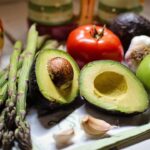
A great guide for parents and garden cultivators, we should always educate children about sustainable gardening